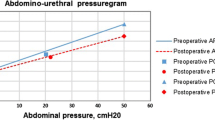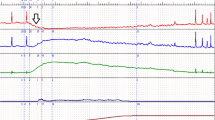Abstract
We evaluated the parameters of preoperative pressure-flow for predicting the postoperative voiding difficulties in women with stress urinary incontinence. The preoperative urodynamic study records of 14 women treated using the tension-free vaginal tape (TVT) procedure were retrospectively analyzed. Of the patients treated with the TVT procedure, urinary retention occurred in one patient, and three had a residual urine volume of more than 30 ml. All patients became completely free of stress urinary incontinence postoperatively. The lowest Pdet max (5 cmH2O) in the preoperative pressure-flow study was found in a patient with a remarkable postoperative residual urine volume of more than 50 ml. The second lowest Pdet max value (8 cmH2O) was seen in a patient with postoperative urinary retention, whose residual urine volume, however, decreased to almost zero 1 year after the operation. The preoperative Pdet max×Qave values were remarkably low for these three patients, including the one with the lowest Pdet max, with a post-void residual urine volume of more than 30 ml. The plots of Pdet max×Qave versus the age of patients show that the Pdet max×Qave values tend to decrease with aging. The preoperative Pdet max×Qave value can be an important parameter for predicting increased residual urine after TVT sling surgery.




Similar content being viewed by others
References
Bergman A, Bhatia NN (1985) Uroflowmetry for predicting postoperative voiding difficulties in women with stress urinary incontinence. Br J Obstet Gynaecol 92: 835
Bergman A, Bhatia NN (1988) Changes in detrusor contractility after incontinence surgery. Urology 31: 354
Boustead GB (2002) The tension-free vaginal tape for treating female stress urinary incontinence. BJU Int 89: 687
Deval B, Jeffry L, Najjar FA, Soriano D, Darai E (2002) Determinants of patient dissatisfaction after a tension-free vaginal tape procedure for urinary incontinence. J Urol 167: 2093
Kuo H-C (1999) Videourodynamic results after pubovaginal sling procedure for stress urinary incontinence. Urology 54: 802
Kuo H-C (2001) Comparison of video urodynamic results after the pubovaginal sling procedure using rectus fascia and polypropylene mesh for stress urinary incontinence. J Urol 165: 163
Nilsson CG, Kuuva N, Falconer C, Rezapour M, Ulmsten U (2001) Long-term results of the tension-free vaginal tape (TVT) procedure for surgical treatment of female stress urinary incontinence. Int Urogynecol J [Suppl 2]: S5
Sander P, Møller LMA, Rudnicki PM, Lose G (2002) Does the tension-free vaginal tape procedure affect the voiding phase? Pressure-flow studies before and 1 year after surgery, BJU Int 89: 694
Ulmsten U, Falconer C, Johnson P, Jomaa M, Lanner L, Nilsson CG, Olsson I (1998) A multicenter study of tension-free vaginal tape (TVT) for surgical treatment of stress urinary incontinence. Int Urogynecol J 9: 210
Ulmsten U, Johnson P, Rezapour M (1999) A three-year follow up of tension free vaginal tape for surgical treatment of female stress urinary incontinence. Br J Obstet Gynaecol 106: 345
Author information
Authors and Affiliations
Corresponding author
Rights and permissions
About this article
Cite this article
Kawashima, H., Hirai, K., Okada, N. et al. The importance of studying pressure-flow for predicting postoperative voiding difficulties in women with stress urinary incontinence: a preliminary study that correlates low Pdet×Qave with postoperative residual urine. Urol Res 32, 84–88 (2004). https://doi.org/10.1007/s00240-003-0378-2
Received:
Accepted:
Published:
Issue Date:
DOI: https://doi.org/10.1007/s00240-003-0378-2




